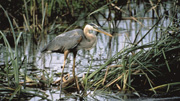Great Blue Heron:
Symbol of the Chesapeake
By Kathy Reshetiloff
Hidden by the morning mist,
a stoic bird patiently keeps watch in the river. Standing motionless,
it waits for the right moment to strike at fish swimming near
its feet. A twig snaps and the once hidden predator reaches, at
first rather clumsily, towards the air. Large blue-grey wings
waft in the air as the bird flies off, its neck tucked into a
tight "S." This is the great blue heron.
 The dignified image is emblazoned on magazines, television, clothing
and even license plates. Surpassed only by the blue crab as a
symbol of the Chesapeake Bay, the great blue heron is the largest
and most widely distributed of American herons and probably the
most familiar of wading birds. Whether flying majestically overhead
or standing motionless at the water's edge, the great blue heron
embodies grace and elegance.
The dignified image is emblazoned on magazines, television, clothing
and even license plates. Surpassed only by the blue crab as a
symbol of the Chesapeake Bay, the great blue heron is the largest
and most widely distributed of American herons and probably the
most familiar of wading birds. Whether flying majestically overhead
or standing motionless at the water's edge, the great blue heron
embodies grace and elegance.
Easily distinguished from other herons, the great blue is four
feet tall and sports a dark gray body, chestnut thighs, and white
crown, cheeks, and throat. Two long, telltale black feathers rise
from the black crown stripe. Typical of herons, great blues have
a short tail, extremely long legs and neck and a sharp bill. While
in flight, its legs trail behind and the bird is kept aloft by
powerful wings that can span six feet.
Great blue herons breed across the United States and southern
Canada. More than half of the Atlantic coast breeding population
nests in the Chesapeake Bay area. Although many herons migrate
through the Bay region, great blue herons often remain as year-round
residents, flying further south only as water freezes and food
is unavailable. These waterbirds hunt silently, cautiously stalking
small fish which they swallow head first. They may also eat frogs,
salamanders, lizards, snakes, crawfish, small birds, rodents and
insects.
Herons form pairs in March and April and primarily breed in colonies,
called rookeries, some of which may support hundreds of nesting
pairs. In the Chesapeake Bay region, nesting sites include living
or dead trees and sometimes bushes. Nests are constructed of sticks
and twigs. If not collapsed by winter weather, old nests may be
repaired and used year after year. The nest is lined with reeds,
mosses and grasses which cushion three to seven eggs.
Eggs hatch after about 28 days, and both parents care for the
chicks. The young are initially fed a diet of regurgitated food
but eventually eat whole fish dropped into the nest. Juveniles
leave the nest after about 60 days and, if they survive their
first winter, may live up to 15 years.
In the past, herons and egrets were shot for their feathers, which
were used to adorn hats and garments. Because of their size, herons
were often the victims of target practice. The slaughter of these
birds went relatively unchecked until 1900 when the federal government
passed the Lacey Act, which prohibits the foreign and interstate
commercial trade of feathers. Greater protection came in 1918
with the Migratory Bird Treaty Act, which prohibits the killing
of migratory birds (except for regulated harvesting of game birds
and special permitted removal). This act also prohibits the collection
of nests, eggs and body parts of migratory birds.
In recent years, great blue herons have had to face new threats.
Deterioration of water quality and loss of habitat threatens herons
and other waterbirds. Areas of shallow water habitat are destroyed
during land development, resulting in the loss of fish and other
prey. Toxic chemicals that enter the Bay from runoff and industrial
discharges threaten all Bay inhabitants. Although great blue herons
currently appear to tolerate low levels of pollutants, these chemicals
can move through the food chain, accumulate in the tissues of
prey, and may eventually cause reproductive failure of birds including
herons.
Care must be taken to preserve nesting sites as well as feeding
areas. Known colonies and nesting sites must be protected. To
minimize disturbance, nesting sites should be observed from a
distance of about 600 feet. Frequently, disturbed herons may abandon
their nests or neglect their young.
Presently, Chesapeake Bay watershed is home to relatively stable
populations of great blue herons, but we cannot become complacent
in our efforts to protect them. Preservation of shallow water
habitat, feeding areas and rookeries must remain a priority if
we want to enjoy this majestic symbol of the Chesapeake Bay.
 After
10 years as a biologist, Kathy Reshetiloff now writes on
a variety of topics for the U.S. Fish and Wildlife Service,
U.S. Department of the Interior. After
10 years as a biologist, Kathy Reshetiloff now writes on
a variety of topics for the U.S. Fish and Wildlife Service,
U.S. Department of the Interior.
|
Back
|

